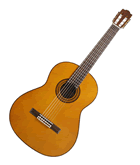After playing air-guitar for 14 years ("We are Wyld Stallyns!"), you've decided to grab a piece of wood and become the world's newest guitar virtuoso. You can see it now… The bright lights on your face. The audience cheering before you. You've even got your own midget sidekick riling up the crowd.
Easy there, Rick Springfield. Before you're ready to take on Shea Stadium, you've got to have a guitar in your hands that won't sound like a goat suffering through a rectal exam. And we're going to show you how to buy the best acoustic guitar for all of your playing needs (and dreams). And we promise to never mention the rectal goat again.
1. CHOOSE BETWEEN A STEEL-STRING ACOUSTIC GUITAR AND A CLASSICAL GUITAR
Before we move on to the first major choice of whether you want a steel-string acoustic guitar or a classical guitar, you must first familiarize yourself with the parts of a guitar:
- Body: The big huge part with the hole in it.
- Sound hole: The big hole in the body where the sound comes out.
- Strings: These are what you pluck to make music, moron. There are 6 of them.
- Bridge: The bar where the strings are attached to the body of the guitar.
- Neck: The really long thing that the strings run along. You'll notice that the neck is subdivided into partitions called frets.
- Nut: At the end of the neck are six grooves that the strings nestle in.
- Headstock: The top, which houses the six tuning pegs used to tune the strings.
 If you're rather nerdy in nature and would like to learn exactly how a guitar works in great mathematical detail, check out this site.
If you're rather nerdy in nature and would like to learn exactly how a guitar works in great mathematical detail, check out this site.So now comes your first big decision: Do you want a steel-string acoustic guitar, or a classical guitar?
Steel-string acoustic guitar
The steel-string acoustic guitar is what you're probably most familiar with; you've seen them played at bars and at concerts. These guitars have steel strings, which provide a thick, rich, vibration-y sound. These guitars are very popular in pop and blues music.
If you're a beginner, some people will tell you that you should not get a steel-string guitar because it will hurt your precious little fingers. True, it will hurt your fingers at the beginning, but you'll eventually develop calluses that will ease your pain. So if you think that the steel-string acoustic sounds better or is more your style, then feel free to get one.
Classical Guitar
The classical guitar has nylon strings, which provide a rounder, smoother tone than its steel-string cousin. Nylon strings are much softer than steel strings (you don't wear steel pantyhose, do you?). Nylon strings also have less "sustain," which means that any plucked note will die more quickly. Still, there are people who would swear that the nylon strings provide more sound control than steel strings.
There are several other differences between steel-string and classical guitars:
- Classical guitars are not nearly as loud as steel-string acoustics.
- The classical guitar has a much wider neck than the steel-string; this can be a bad thing if your hands are small.
- One rarely strums the classical guitar, as fingerpicking is the norm.
- Classical guitars have a smaller body than steel-string acoustics, so they might be a little more portable if you're interested in taking your guitar with you to lots of places.

